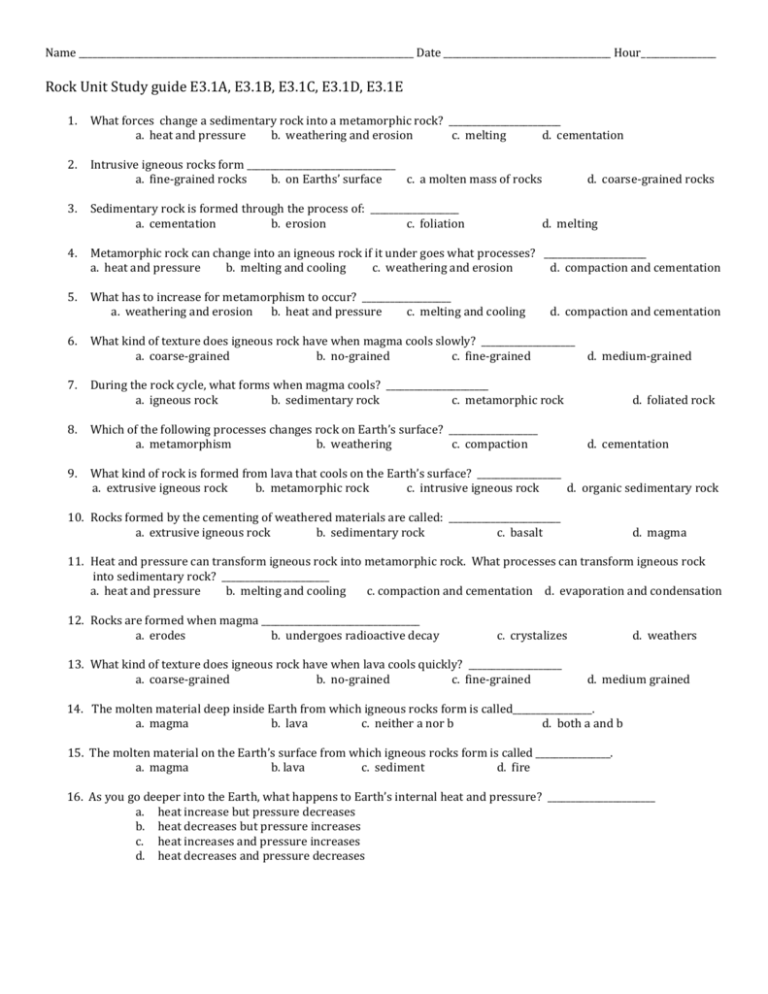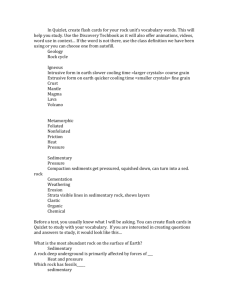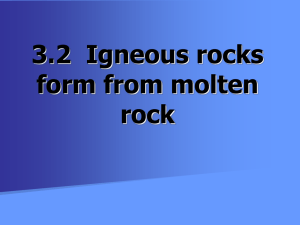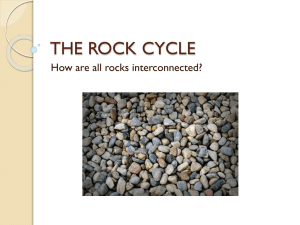study-guided-for-test-on
advertisement

Name ________________________________________________________________________ Date ____________________________________ Hour________________ Rock Unit Study guide E3.1A, E3.1B, E3.1C, E3.1D, E3.1E 1. What forces change a sedimentary rock into a metamorphic rock? ________________________ a. heat and pressure b. weathering and erosion c. melting d. cementation 2. Intrusive igneous rocks form ________________________________ a. fine-grained rocks b. on Earths’ surface c. a molten mass of rocks d. coarse-grained rocks 3. Sedimentary rock is formed through the process of: ___________________ a. cementation b. erosion c. foliation 4. Metamorphic rock can change into an igneous rock if it under goes what processes? ______________________ a. heat and pressure b. melting and cooling c. weathering and erosion d. compaction and cementation 5. What has to increase for metamorphism to occur? ___________________ a. weathering and erosion b. heat and pressure c. melting and cooling 6. What kind of texture does igneous rock have when magma cools slowly? ____________________ a. coarse-grained b. no-grained c. fine-grained d. medium-grained 7. During the rock cycle, what forms when magma cools? ______________________ a. igneous rock b. sedimentary rock c. metamorphic rock 8. 9. d. melting d. compaction and cementation Which of the following processes changes rock on Earth’s surface? ___________________ a. metamorphism b. weathering c. compaction d. foliated rock d. cementation What kind of rock is formed from lava that cools on the Earth’s surface? __________________ a. extrusive igneous rock b. metamorphic rock c. intrusive igneous rock d. organic sedimentary rock 10. Rocks formed by the cementing of weathered materials are called: ________________________ a. extrusive igneous rock b. sedimentary rock c. basalt d. magma 11. Heat and pressure can transform igneous rock into metamorphic rock. What processes can transform igneous rock into sedimentary rock? _______________________ a. heat and pressure b. melting and cooling c. compaction and cementation d. evaporation and condensation 12. Rocks are formed when magma __________________________________ a. erodes b. undergoes radioactive decay c. crystalizes 13. What kind of texture does igneous rock have when lava cools quickly? ____________________ a. coarse-grained b. no-grained c. fine-grained d. weathers d. medium grained 14. The molten material deep inside Earth from which igneous rocks form is called_________________. a. magma b. lava c. neither a nor b d. both a and b 15. The molten material on the Earth’s surface from which igneous rocks form is called ________________. a. magma b. lava c. sediment d. fire 16. As you go deeper into the Earth, what happens to Earth’s internal heat and pressure? _______________________ a. heat increase but pressure decreases b. heat decreases but pressure increases c. heat increases and pressure increases d. heat decreases and pressure decreases On your answer sheet, write the correct bold word from each sentence below to make the sentences true. 17. Extrusive igneous rock are formed above / below the Earth’s surface. The substance they form from is lava / magma. They produce small / large crystals because they form from the magma / lava cooling fast / slow. 18 Intrusive igneous rock are formed above / below the Earth’s surface. The substance they form from is lava / magma. They produce small / large crystals because they form from the magma / lava cooling fast / slow. 19. Vesicular rocks are formed when gases get trapped / escape because the lava / magma is too thick / hot. 20. Porphyritic rocks form from magma / lava cooling below / above the surface of the Earth slowly / quickly, then all of a sudden it gets shot up to the Earth’s surface / gets pushed down below Earth’s surface and begins to rapidly cool / slowly cool. Match the words on the right with their proper definitions on the left. ____________21. These metamorphic rocks are characterized by layers or bands of minerals that are perpendicular to the pressure applied on them. a. contact metamorphism ____________22. This is the percentage of open space between grains in a rock. c. deposition ____________23. These metamorphic rocks are composed mainly of minerals that form with blocky crystal shapes. d. foliated rocks ____________24. When molten material, such as an igneous intrusion comes in contact with solid rock. This is from high temperatures and moderate to low pressure. Temperatures decrease with distance from the intrusion, therefore the metamorphic change also decrease with distance. b. nonfoliated rocks e. regional metamorphism f. physical weathering g. erosion h. chemical weathering ____________25. The physical and chemical process that transform sediments into sedimentary rock i. lithificatoin ____________26. When the minerals in a rock are dissolved or chemically changed. j. porosity ____________27. When high temperatures and pressure affect large regions of Earth’s crust. The result of this is changes in mineral and rock types, plus folding and deforming of the rock layers that make up the area. ____________28. When the rock minerals remain unchanged. The rock just breaks apart along fractures or grain boundaries. ____________29. Process by which sediment is dropped and comes to rest ____________30. Process by which sediment is removed from its source Choose ONE of the following and answer it. Make sure you have complete detailed sentences. (4 pts. each) 31. What causes rocks to have smooth well rounded surfaces? 32. Describe fine-grained sedimentary rocks. (Shale) (Where are they found? How do they form? Why do they form this way?) 33. Describe medium-grained sedimentary rocks. (sandstone) (Where are they found? What type of sediments are they made of)








